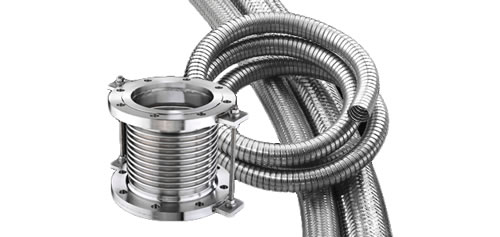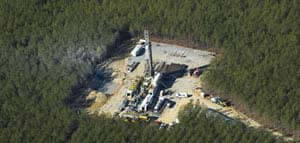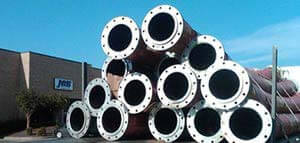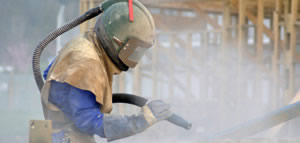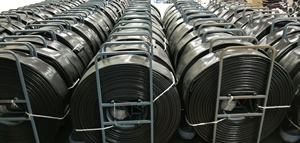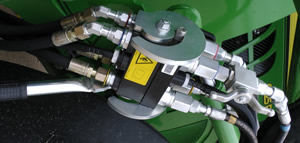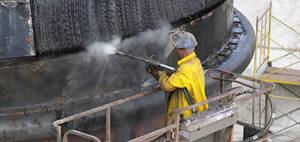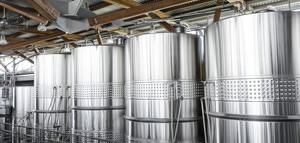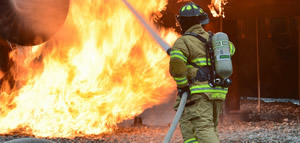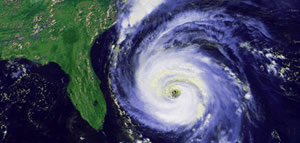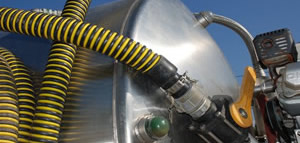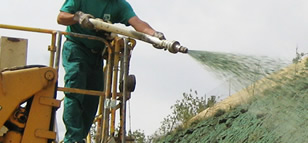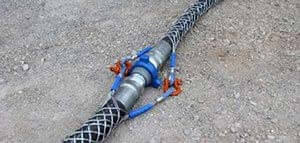Hose Industry Glossary of Terms
Abrasion: External damage to a hose assembly caused by its being rubbed by a foreign object; a wearing away by friction.
Abrasion tester: a machine for determining the quantity of material worn away by friction under specified conditions.
Absorption: regarding hose, the process of taking in fluid. Hose materials are often compared with regard to relative rates and total amounts of absorption as they pertain to specific fluids.
Accelerated life test: a method designed to approximate in a short time the deteriorating effects obtained under normal service conditions.
Acid resistant: having the ability to withstand the action of identified acids within specified limits of concentration and temperature.
Adapter, Adaptor: 1) fittings of various sizes and materials used to change an end fitting from one type to another type or one size to another. (i.e., a male JIC to male pipe adapter is often attached to a female JIC to create a male end union fitting); 2) the grooved portion of a cam & groove coupling.
Adhesion: the strength of bond between cured rubber surfaces or between a cured rubber surface and a non-rubber surface.
Adhesion failure: (1) the separation of two bonded surfaces at an interface by a force less than specified in a test method; (2) the separation of two adjoining surfaces due to service conditions.
Adhesive: a material which, when applied, will cause two surfaces to adhere.
Aerostatic testing: see Pneumatic testing.
Afterglow: in fire resistance testing, the red glow persisting after extinction of the flame.
Algaflon®: a registered trademark of Ausimont USA. See PTFE.
Air oven aging: a means of accelerating a change in the physical properties of rubber compounds by exposing them to the action of air at an elevated temperature at atmospheric pressure.
Air under water testing: see Pneumatic testing.
Ambient temperature: the temperature of the atmosphere or medium surrounding an object under consideration.
Ambient/atmospheric conditions: the surrounding conditions, such as temperature, pressure, and corrosion, to which a hose assembly is exposed.
Amplitude of vibrations and/or lateral movement: the distance a hose assembly deflects laterally to one side from its normal position, when this deflection occurs on both sides of the normal hose centerline.
Anchor: a restraint applied to eliminate motion and restrain forces.
Angular displacement: displacement of two parts defined by an angle.
Annular: refers to the convolutions on a hose that are a series of complete circles or rings located at right angles to the longitudinal axis of the hose (sometimes referred to as "bellows").
ANSI: American National Standards Institute.
Antistatic: see Static conductive.
Application working pressure: unique to customer's application. See pressure, working.
Application: the service conditions that determine how a hose assembly will be used.
Armor: a protective cover slid over and affixed to a hose assembly; used to prevent over bending or for the purpose of protecting hose from severe external environmental conditions such as hot materials, abrasion or traffic.
Assembly: a general term referring to any hose coupled with end fittings of any style attached to one or both ends.
ASTM: American Society for Testing and Materials.
Attachment: the method of securing an end fitting to a hose (e.g., banding, crimping, swaging, or screw-together-2 piece or 3 piece-style-reusable fittings).
Autoclave: an apparatus using superheated high pressure steam for sterilization, vulcanization and other processes.
Axial movement: compression or elongation along the longitudinal axis.
Backing: a soft rubber layer between a hose tube and/or cover and carcass to provide adhesion.
Band: (1) a metal ring that is welded, shrunk, or cast on the outer surface of a hose nipple or fitting; (2) a thin strip of metal used as a non-bolted. See Hose clamp.
Barb: the portion of a fitting (coupling) that is inserted into the hose, usually comprised of two or more radial serrations or ridges designed to form a redundant seal between the hose and fitting.
Barbed and ferrule fitting: a two-piece hose fitting comprised of a barbed insert (nipple), normally with peripheral ridges or backward-slanted barbs, for inserting into a hose and a ferrule, usually crimped or swaged.
Basket weave: a braid pattern in which the plaits of wire alternately cross over and under two strands (two over-two under).
Bench marks: marks of known separation applied to a specimen used to measure strain (elongation of specimen).
Bench test: a modified service test in which the service conditions are approximated in the laboratory.
Bend radius: the radius of a bent section of hose measured to the innermost surface of the curved portion.
Bend radius, minimum: the smallest radius at which a hose can be used. For Metal Hose: -the radius of a bend measured to the hose centerline, as recommended by the manufacturer.
Bend radius, dynamic: the radius at which constant or continuous flexing occurs.
Bending force: an amount of stress required to induce bending around a specified radius and hence, a measure of stiffness. Bend radius, static: the smallest fixed radius at which a hose can be subjected.
Bevel seat fitting: see Fitting, Bevel Seat.
Beverly shear: hand or pneumatically operated, table mounted, metal cutting shear used to cut medium pressure hose of PTFE.
Billet: (1) a compressed cylinder of PTFE resin, from which raw tubing is extruded. Also called a preform. (2) a solid piece of material from which a fitting is manufactured.
Bleeding: surface exudation. See Bloom.
Blister: a raised area on the surface or a separation between layers usually creating a void or air-filled space in a vulcanized article.
Bloom: a discoloration or change in appearance of the surface of a rubber product caused by the migration of a liquid or solid to the surface, (e.g. sulfur bloom, wax bloom). Not to be confused with dust on the surface from external sources.
Blow out force: the force generated from the internal pressure attempting to push the fitting from the hose.
Body wire: normally a round or flat wire helix embedded in the hose wall to increase strength or to resist collapse.
Bolt hole circle: a circle on the flange face around which the center of the bolt holes are distributed.
Bore: (1) an internal cylindrical passageway, as of a tube, hose or pipe; (2) the internal diameter of a tube, hose, or pipe.
Bowl: (1) the exterior shell of an expansion ring type coupling; (2) the larger internal diameter of the internal portion of a ferrule.
Braid: the woven portion of a hose used as reinforcement to increase pressure rating and add hoop strength. Various materials such as polyester, cotton or metal wire are used. A hose may have one or more braids, outside or between layers of hose material.
Braid angle: the angle developed at the intersection of a braid strand and a line parallel to the axis of a hose.
Braid coverage: the relative amount of braid material covering a hose expressed as a percent.
Braid make up: description of braid (i.e., 32-12-.015, T321 55), where: 32 is the number of carriers; 12 is the number of wires on each carrier; .015 is the wire diameter in inches; and T321 55 is the material, (Type 321 stainless steel).
Braid sleeve/ring/ferrule: a ring made from tube or metal strip placed over the ends of a braided hose to contain the braid wires for attachment of fitting and ferrule, and to immobilize heat affected corrugations.
Braid wear: motion between the braid and corrugated hose, which normally causes wear on the outside diameter of the corrugation and the inside diameter of the braid.
Braided braid: a braid where the strands of wire on each carrier of the braiding machine are braided together, and then braided in normal fashion.
Braided ply: a layer of braided reinforcement.
Braid-over-braid: multiple plies of braid having no separating layers.
Brand: a mark or symbol identifying or describing a product and/or manufacturer, that is embossed, inlaid or printed.
Brass: a family of copper/zinc alloys.
Brazing: a process of joining metals using a nonferrous filler metal having a melting point that is lower than the "parent metals" to be joined, typically over +800°F.
Bronze: an alloy of copper, tin and zinc.
Buffing (sizing): grinding a surface to obtain dimensional conformance or surface uniformity.
Bumped convoluted: a type of hose (typically fluoroplastic) made by re-forming a smooth bore tube to create annular or helical ridges or convolutions, and allow the cuffed ends to extend through the end fittings, and be flared over the fitting face, providing a seamless assembly with no metal contact. Typically used in high corrosion and sanitary applications.
Bunch braid: braid applied to hose in bundles rather than flat strands (plaits), usually done to achieve high pressure versus hose weight.
Butt weld: process in which the edges or ends of metal sections are butted together and joined by welding.
C of C Certificate of conformance or certificate of compliance; a document, usually signed and dated pertaining to a particular lot or purchase ( )f item(s), which describes any standards, specifications, tests, materials and/or performance attributes to which the referenced item(s) have met or will meet.
Cam & groove: see Fitting/coupling -Cam & Groove.
Capped end: a hose end covered to protect its internal elements.
Carcass: the fabric, cord and/or metal reinforcing section of a hose as distinguished from the hose tube or cover.
Casing: see Armor.
Cement: unvulcanized raw or compounded rubber in a suitable solvent used as an adhesive or sealant.
Cemented end: a hose end sealed with the application of a liquid coating.
Chafe sleeve: an outer sleeve providing resistance to chafing and external resistance to damage to braided hoses, available in wide variety of materials to meet the application requirements (e.g., chafe sleeves include slip-on, heat shrinkable, integrally extruded).
Chalking: the formation of a powdery surface condition due to disintegration of surface binder or elastomer by weathering or other destructive environments.
Checking: the short, shallow cracks on the surface of a rubber product resulting from damaging action of environmental conditions.
Chemical compatibility: the relative degree to which a material may contact another without corrosion, degradation or adverse change of properties.
Chemical resistance: the ability of a particular polymer, rubber compound, or metal to exhibit minimal physical and/or chemical property changes when in contact with one or more chemicals for a specified length of time, at specified concentrations, pressure, and temperature.
Clamp: see Hose clamp.
Cloth impression: see Fabric impression.
Coefficient of friction: a relative measure of the surface lubricity.
Cold flex: see Low temperature flexibility.
Cold flexibility: relative ease of bending while being exposed to specified low temperature.
Cold flow: continued deformation under stress. See Creep.
Collar: 1) the portion of a fitting that is compressed by swaging or crimping to seal the hose onto the fitting barbs and create a permanent attachment; also called a ferrule. (With reusable fittings, the lock and seal are accomplished mechanically by the collar without swaging or crimping); 2) a raised portion on the hose shank which functions as a connection for a ferrule or other locking device or functions as a hose stop.
Combustible liquid: a combustible liquid is one having a flash point at or above +100°F (37.8°C).
Composite hose: non-vulcanized hose that consists of the following:
An internal wire helix; A multi-ply wall of thermoplastic films and reinforcing
fabrics in proportions that give the required physical properties and provide
a complete seal. (Note: The film content may be built of tubular films.)
A cover consisting of fabric with an abrasion resistant polymeric coating;
An external helix wire.
Compound: the mixture of rubber or plastic and other materials, which are combined to give the desired properties when. Used in the manufacture of a product.
Compression fitting: see Fitting/coupling -Compression
Compression set: the deformation which remains in rubber after it has been subjected to and released from a specific compressive stress for a definite period of time at a prescribed temperature. (Compression set measurements are for evaluating creep and stress relaxation properties of rubber.)
Concentricity: the uniformity of hose wall thickness as measured in a plane normal to the axis of the hose.
Conditioning: the exposure of a specimen under specified conditions, e.g., temperature, humidity , for a specified period of time before testing .
Conductive: the ability to transfer electrical potential.
Configuration: the combination of fittings on a particular assembly.
Control: a product of known characteristics, which is included in a series of tests to provide a basis for evaluation of other products.
Controlled flexing: occurs when the hose is being flexed regularly, as in the case of connections to moving components (e.g., platen presses, thermal growth in pipe work).
Convoluted: description of hose or inner core having annular or
helical ridges formed to enhance flexibility.
Convolution/corrugation: the annular or helical flexing member in corrugated or strip wound hose/corrugation.
Convolution count: the number of ridges or corrugations per inch of a hose.
Copolymer: a blend of two polymers.
Core: the inner portion of a hose, usually referring to the material in contact with the medium.
Corrosion: the process of material degradation by chemical or electrochemical means.
Corrosion resistance: ability of metal components to resist oxidation.
Corrugated cover: a ribbed or grooved exterior.
Corrugated hose: hose with a carcass fluted, radially or helically, to enhance flexibility or reduce its weight.
Coupler: the female portion of the cam & groove connection with the cam arms.
Coupling: a frequently used alternative term for fitting.
Cover wear: the loss of material during use due to abrasion, cutting or gouging.
Cover: the outer component usually intended to protect the carcass of a product.
CPE: chlorinated polyethylene; a rubber elastomer.
Cracking: a sharp break or fissure in the surface, generally caused by strain and environmental conditions.
Creep: the deformation, in material under stress, which occurs with lapse of time after the immediate deformation.
Crimp diameter: the distance across opposite flats after crimping.
Crimp/crimping: a fitting attachment method utilizing a number of fingers or dies mounted in a radial configuration. The dies close perpendicular to the hose and fitting axis, compressing the collar, ferrule, or sleeve around the hose.
CSM: chlorosulfonated polyethylene.
Cure: the act of vulcanization. See Vulcanization.
Cut off factor: the hose length to be subtracted from the overall assembly length that allows for the hose coupling end connection extension beyond the end of the hose.
Cut resistant: having that characteristic of withstanding the cutting action of sharp object.
Cycle-motion: movement from normal to extreme position and return.
Date Code: any combination of numbers, letters, symbols or other methods used by a manufacturer to identify the time of manufacture of a product.Deburr: to remove ragged edges from the inside diameter of a hose end; an important fabrication step for assembling hose of PTFE in order to insure a good seal.
Deduct length: the amount of fitting length deducted from a hose to result in the desired finished assembly length.
Design factor: a ratio used to establish the working pressure of the hose, based on the burst strength of the hose.
Design pressure: see Application working pressure and Pressure, working.
Developed length: see Overall length.
Diamond weave: braid pattern in which the strands alternately cross over one and under one of the strands (one over-one under); also known as "plain weave."
Die: a tool used to swage or crimp a fitting onto a hose. Swage dies usually consist of two halves machined to a predetermined diameter, designed for a specific hose type and size. A crimp die set is typically six to eight "fingers" designed for infinite diameter settings within a range or preset to a diameter for a given hose type and size.
Dielectric strength: the relative measure of a material's ability to resist conducting an electrical charge.
Displacement: the amount of motion applied to a hose defined as inches for parallel offset and degrees for angular misalignment.
Dog-leg assembly: two hose assemblies joined by a common elbow.
DOT: Department of Transportation.
Duplex assembly: an assembly consisting of two hose assemblies-one inside the other, and connected at the ends; also known as "jacketed assemblies."
Durometer: an instrument for measuring the hardness of rubber and plastic compounds.
Durometer hardness: a numerical value, which indicates the resistance to indentation of the blunt indentor of the durometer.
Dye penetrant inspection/test: nondestructive inspection method for detecting surface defects.
Dynamic bend radius: see bend radius, dynamic.
Eccentric wall: a wall of varying thickness.
Eccentricity: the condition resulting from the inside and outside diameters not having a common center. See eccentric wall.
ECTFE: ethylene-chlorotrifluoroethylene.
Effective thrust area-hose: cross-sectional area described by the mean diameter of the hose.
Effusion: the escape, usually of gases, through a material. See Permeation.
Elastic limit: the limiting extent to which a body may be deformed and yet return to its original shape after removal of the deforming force.
Elastic/intermittent flexure: The smallest radius that a given hose can be bent to without permanent deformation to the metal in its flexing members (convolutions or corrugations).
Elastomer: anyone of a group of polymeric materials, usually designated thermoset, such as natural rubber, or thermoplastic, which will soften with application of heat.
Electrostatic discharge: the sudden discharge of static electricity from an area of buildup to a grounding point.
Elongation: the increase in length expressed numerically as a percentage of the initial length.
Encapsulated fitting: see Fitting/coupling-Encapsulated fittings.
Endurance test: a service or laboratory test, conducted to product failure, usually under normal use conditions.
Enlarged end: an end having a bore diameter greater than that of the main body of the hose, in order to accommodate a larger fitting.
EPDM: Ethylene Propylene Diene Monomer; an elastomer.
Exothermic: releasing heat.
Extrude/extruded/extrusion: forced through the shaping die of an extruder; extrusion may have a solid or hollow cross section.
Fabric impression: impression formed on the rubber surface during vulcanization by contact with fabric jacket or wrapper.
Fabricator: the producer of hose assemblies.
Fatigue: the weakening or deterioration of a material occurring when a repetitious or continuous application of stress causes strain, which could lead to failure.
FDA: United States Food and Drug Administration.
FEP: fluorinated ethylene propylene.
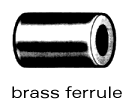 Ferrule: a metal cylinder placed over a hose end to affix the fitting to the hose. See braid sleeve, interlocking ferrule, and sleeve.
Ferrule: a metal cylinder placed over a hose end to affix the fitting to the hose. See braid sleeve, interlocking ferrule, and sleeve.
Fire sleeve: slip-on or integrally extruded sleeve used to retard the effects of fire in certain applications; most often made with silicone and/or ceramic fiber.
Fitting/coupling: a device attached to the end of the hose to facilitate connection. The following is only a partial list of types of fittings available-
Banjo Fitting- a through bolted designed featuring a hollow circle or "donut" attached to one end of the fitting barb so that the inner diameter is along the hose axis.
Barbed inserts-  for low or medium pressure air, water and fluids. Machined brass with serrated shank; NPT or NPTF male and solid female, and NPSM swivel female; thread seal to NPT or NPTF female, and ball end or washer seal to NPSM female. Attached with bands or clamps.
for low or medium pressure air, water and fluids. Machined brass with serrated shank; NPT or NPTF male and solid female, and NPSM swivel female; thread seal to NPT or NPTF female, and ball end or washer seal to NPSM female. Attached with bands or clamps.
Butt Weld Fittings -a hose fitting designed to be permanently welded to a connecting member such as another pipe or a butt weld flange.
Cam & Groove Fittings -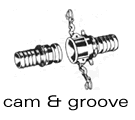 a type of fitting that allows connection and disconnection by means of arm(s) or cam(s) on the female fitting. The seal is accomplished by means of a gasket, available in various materials. These fittings are frequently used on product transfer hose assemblies.
a type of fitting that allows connection and disconnection by means of arm(s) or cam(s) on the female fitting. The seal is accomplished by means of a gasket, available in various materials. These fittings are frequently used on product transfer hose assemblies.
Compression Fitting -a fitting style that seals on a mating tube by compressing an internal ferrule against the tube O.D..
Encapsulated Fittings- a metal fitting of various styles usually encased in a thermoplastic or fIuoroplastic material by means of molding or coating. Most often done for sanitary purposes or to eliminate corrosion.
Field Attachable Fitting- a fitting designed to be attached to hose without crimping or swaging. This fitting is not always a Reusable type fitting.
Flange Retainer Fittings -a hose fitting flared to a 90° surface, designed to hold a circular rotating flange, such as a slip-on or lap joint style flange.
Flange Style Fittings -pipe flanges and flanged fitting standards are listed under ANSI 816.5. Flanges are rated for pressure and listed as "American Class 150, 300, 400, 600, 900, 1,500 or 2,500". Pressure- Temperature ratings can be obtained by consulting the ANSI specification or ASME 816.5 (American Society of Mechanical Engineers). Designs vary by neck and face style, or other dimensional changes based on use. Various finishes or grooves may be applied to the face for sealing on a gasket or O-ring. Bolt holes and other dimensions are per the ANSI standard.
Slip-on Flange -a flange designed to slip over a flange retainer and float freely in place for bolt alignment. Similar to a lap joint flange except with a very small radius on the face side of the inside diameter to mate with a machined flange retainer. May have a flat or raised face.
Lap Joint Flange -a flange designed to float freely on the flange retainer for bolt alignment. Made with a flat face and having a large radius on the I.D. to mate with a flared pipe style flange retainer.
Threaded Flange -a flange, the inside diameter of which is threaded to attach to a male pipe fitting. A leak proof seal, made with thread sealant, usually does not allow for bolt hole alignment.
 Interlocking- for high pressure air and water service, steam, high pressure spray, and LPG service. Plated malleable iron; insert and spud may be either steel or malleable iron; NPT male and female with ground joint or washer seal. Attached with four bolts or two interlocking clamps.
Interlocking- for high pressure air and water service, steam, high pressure spray, and LPG service. Plated malleable iron; insert and spud may be either steel or malleable iron; NPT male and female with ground joint or washer seal. Attached with four bolts or two interlocking clamps.
Interlocking Clamp- 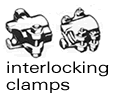 Heavy duty high pressure applications such as air, steam, water, spray. Malleable iron, plated. Clamps are bolted into position.
Heavy duty high pressure applications such as air, steam, water, spray. Malleable iron, plated. Clamps are bolted into position.
Inverted Flare Fitting-a fitting consisting of a male or female nut, trapped on a tube by flaring the end of the tube material to either 37° or 45°.
JIC Fittings -joint Industrial Council (no longer in existence). An engineering group that established an industry standard fitting design incorporating a 37° mating surface, male and female styles. These standards now governed by SAE.
Lined Fitting -any fitting of which the wetted surface or entire fitting is covered with a protective material. The covering process may be by spray coating, molding or by inserting hose liner through the I.D. of fitting and anchoring.
Long Shank-  designed for medium pressure air, water, sanitary and liquids in suction or discharge service. Machined brass with serrated shank; NPT or NPTF male and solid female, and NPSM swivel female; thread seal to NPT or NPTF female, and ball end washer seal to NPSM female. Attached with clamps or bands.
designed for medium pressure air, water, sanitary and liquids in suction or discharge service. Machined brass with serrated shank; NPT or NPTF male and solid female, and NPSM swivel female; thread seal to NPT or NPTF female, and ball end washer seal to NPSM female. Attached with clamps or bands.
O-ring Fittings: a fitting that seals by means of an elastomeric ring of a specified material.
Pipe Thread Fittings -
NPT- National Pipe Taper. Pipe thread per ANSI B1.20.1
NPTF- National Pipe Tapered for Fuels. Same as above except dry-seal per ANSI B1.20.3
NPSH- National Pipe Straight Hose per ANSI B1.20.7
NPSM- National Pipe Straight Mechanical. Straight thread per ANSI B1.20.1
NPSL- National Pipe Straight Loosefit per ANSI B1.20.1
BSPP, BSPT- British Standard Pipe Parallel, British Standard Pipe Taper. BS21.
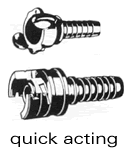 Quick Acting- for low to medium pressure; air, water or oil service where frequent and fast connections must be made. Malleable iron plated, stainless steel or bronze. Attached with interlocking clamps or bands.
Quick Acting- for low to medium pressure; air, water or oil service where frequent and fast connections must be made. Malleable iron plated, stainless steel or bronze. Attached with interlocking clamps or bands.
Quick Connect Fitting -a fitting designed to quickly connect and disconnect. These fittings come in many styles and types.
Reusable Fitting- a fitting designed to be attached and unattached to a hose, allowing all or most of the fitting to be reused.
Sanitary Fittings -a fitting whose seal is accomplished by means of a round gasket in a groove on the face of the fitting. The design eliminates the need for a male and female, since the fitting mates to itself. A re-attachable clamp is also used for coupling.
Bevel Seat -a type of sanitary fitting incorporating a 45° beveled sealing surface. Used in the food and pharmaceutical industries.
 Combination Nipple- for low or medium pressure suction and discharge of water, fluids, and material handling. Tubular steel, stainless, malleable iron, aluminum or brass with serrated shank; NPT male threads, grooved, or beveled for welding. Attached with clamps or bands.
Combination Nipple- for low or medium pressure suction and discharge of water, fluids, and material handling. Tubular steel, stainless, malleable iron, aluminum or brass with serrated shank; NPT male threads, grooved, or beveled for welding. Attached with clamps or bands.
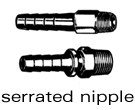 Serrated Nipple - for medium to high pressure air, water, and liquid service. Machined steel and plated; NPT male threads; thread or washer seal. Attached with clamps or bands
Serrated Nipple - for medium to high pressure air, water, and liquid service. Machined steel and plated; NPT male threads; thread or washer seal. Attached with clamps or bands
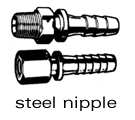 Steel Nipple - for medium to high pressure; wide variety of applications. Machined from cold drawn bar steel, heat treated for toughness. Attached with interlocking clamps.
Steel Nipple - for medium to high pressure; wide variety of applications. Machined from cold drawn bar steel, heat treated for toughness. Attached with interlocking clamps.
 Short Shank- designed for low pressure water and air service. Cast brass with serrated shank; GHT, NPSM or NPT male and HPSH female; washer seal. Attached with clamps or bands.
Short Shank- designed for low pressure water and air service. Cast brass with serrated shank; GHT, NPSM or NPT male and HPSH female; washer seal. Attached with clamps or bands.
Split Flange Fitting- a fitting consisting of a flange retainer and a flange of two halves. This design allows the flanges to be installed after the retainer has been attached to the hose, making the flange reusable. SAE Code 61 and 62.
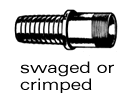 swaged or crimped - for use on all types of hose where high pressures are used. Couplings consist of swaged fitting shaving serrated steel shanks with ferrules of plated steel. Attached with swaging or crimping equipment.
swaged or crimped - for use on all types of hose where high pressures are used. Couplings consist of swaged fitting shaving serrated steel shanks with ferrules of plated steel. Attached with swaging or crimping equipment.
Tube Fitting- a hose fitting of which the mating end conforms to a tube diameter. The mate or male end of a compression fitting.
2-Bolt Flange Fitting- an elliptical flange with two bolt holes. Typically used in steam applications such as laundry and tire presses.
 Water Suction-Heavy duty water discharge and suction service. Malleable iron and/or brass. Attached with clamps or bands.
Water Suction-Heavy duty water discharge and suction service. Malleable iron and/or brass. Attached with clamps or bands.
Flammable gases/liquid/media: a flammable gas, including liquefied gas, is one having a closed cup flash point below +100°F (+37.8°C) and a vapor pressure greater than 25 psi. (174.2 KPa).
Flat spots: flat areas on the surface of cured hose caused by deformation during vulcanization.
Flex cracking: a surface cracking induced by repeated bending and straightening.
Flex life: the relative ability of an article to withstand bending stresses.
Flex life test: a laboratory method used to determine the life of a rubber product when subjected to dynamic bending stresses.
Flow rate: a volume of media being conveyed in a given time period.
Fluid: a gas or liquid medium.
Fluid velocity: the speed of fluid through a cross section expressed in length divided by time.
Fluorocarbon: an organic compound containing fluorine directly bonded to carbon. The ability of the carbon atom to form a large variety of structural chains gives rise to many fluorocarbons and fluorocarbon derivatives.
Fluron®: a registered trademark of ICI. A term descriptive of the family of fluorocarbons and fluorocarbon derivatives in general commercial use. See PTFE.
Fluoropolymer: a high molecular weight (long chain) chemical containing fluorine as a major element.
Free length: the lineal measurement of hose between fittings or couplings.
Frequency: the rate of vibration or flexure in a given time period.
Galvanic corrosion: corrosion that occurs on the less noble of two dissimilar metals in direct contact with each other in an electrolyte, such as water, sodium chloride in solution, sulfuric acid, etc.
GMAW: Gas Metal Arc Weld.
GPM: Gallons per minute.
GTAW: see Tig Weld/GTAW.
Guide (for piping): a device that supports a pipe radially in all directions, but directs movement.
Halar®: Ausimont USA registered trademark. See ECTFE.
Hand built hose: a hose made by hand on a mandrel, reinforced by textile or wire or combination of both.
Hardness: resistance to indentation. See Durometer hardness.
Heat resistance: the property or ability to resist the deteriorating effects of elevated temperatures.
Heat-shrink sleeving: tubular thermoplastic sleeve used for chafe protection or identification. The sleeve is slipped over the hose and shrunk down by the application of heat to fit tightly on the hose.
Helical wire armor/spring guard: an abrasion resistance device.
Helical: used to describe a type of corrugated hose having one continuous convolution resembling a screw thread.
Helix: a shape formed by spiraling a wire or other reinforcement around the cylindrical body of a hose; typically used in suction hose.
Higbee: the thread of a hose coupling, the outermost convolution of which has been removed to such an extent that a full cross section of the thread is exposed, this exposed end being beveled.
Hoop strength: the relative measure of a hose's resistance to collapse of the diameter perpendicular to the hose axis.
Hose: a flexible conduit consisting of a tube, reinforcement, and usually an outer cover.
Hose assembly: see Assembly.
Hose clamp: a device used to hold a hose onto a fitting.
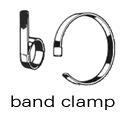 Band Clamp - use with low or medium pressure and suction service. Pre-formed flat stainless steel, high carbon steel. Attached with special locking band tool.
Band Clamp - use with low or medium pressure and suction service. Pre-formed flat stainless steel, high carbon steel. Attached with special locking band tool.
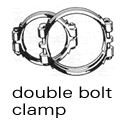 Double Bolt Clamp - use with low or medium pressure and suction service with large sizes of combination nipples or couplings. Cast malleable iron, plated, and brass. Applied over hose and bolted into position.
Double Bolt Clamp - use with low or medium pressure and suction service with large sizes of combination nipples or couplings. Cast malleable iron, plated, and brass. Applied over hose and bolted into position.
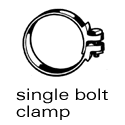 Single Bolt Clamp - use with low pressure and suction service on shank couplings, combination nipples, and pipe nipples. Cast malleable iron, plated. Attached by bolting tightly on hose.
Single Bolt Clamp - use with low pressure and suction service on shank couplings, combination nipples, and pipe nipples. Cast malleable iron, plated. Attached by bolting tightly on hose.
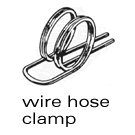 Wire Hose Clamp - suitable for medium pressure air, water or general purpose hose; good for hose with helical wire or corrugations; available in larger sizes for pin lug, serrated pipe nipple or combination. Pre-formed round wire made of stainless steel, galvanized steel, copper, bronze or aluminum. Wire ends pulled and crimped with special tool or machine.
Wire Hose Clamp - suitable for medium pressure air, water or general purpose hose; good for hose with helical wire or corrugations; available in larger sizes for pin lug, serrated pipe nipple or combination. Pre-formed round wire made of stainless steel, galvanized steel, copper, bronze or aluminum. Wire ends pulled and crimped with special tool or machine.
Hostaflon®: a registered trademark of Dyneon. See PFA.
Hydrostatic testing: the use of liquid pressure to test a hose or hose assembly for leakage, twisting, and/or hose change-in-Iength.
Hypalon®: a DuPont registered trademark. See CSM.
Hytrel®: a DuPont registered trademark.
I.D.: the abbreviation for inside diameter.
Identification yarn: a yarn of single or multiple colors, usually embedded in the hose wall, used to identify the manufacturer.
Impression: a design formed during vulcanization in the surface of a hose by a method of transfer, such as fabric impression or molded impression.
Impulse service: an application parameter characterized by continuous cyclical pressure changes from low to high.
Impulse: an application of force in a manner to produce sudden strain or motion, such as hydraulic pressure applied in a hose.
Indentation: 1) the extent of deformation by the indentor point of anyone of a number of standard hardness testing instruments; 2) a recess in the surface of a hose.
Innercore: the innermost layer of a hose; the hose material in contact with the medium.
Insert: optional term for nipple. See Nipple.
Interlocked hose: formed from profiled strip and wound into flexible metal tubing with no subsequent welding, brazing, or soldering; may be made pressure-tight by winding in strands of packing.
Interlocking clamp: a clamp which engages the fitting in a manner which prevents the clamp from sliding off the fitting, typically a bolt or U-bolt style with interlocking fingers which engage an interlock ring on the fitting.
Interlocking ferrule: a ferrule, which physically attaches to the fitting preventing the ferrule from sliding off the fitting.
Interstice: a small opening, such as between fibers in a cord or threads in a woven or braided fabric.
IPT: iron pipe threads; a reference to NPT or NPTF.
ISO: International Organization for Standardization.
Jacket: seamless tubular braided or woven ply generally on the outside of hose.
JIC: see Fitting/coupling-JIC.
Kinking: temporary or permanent distortion of the hose induced by bending beyond the minimum bend radius.
Kynar®: ELF Atochem registered trademark. See PVDF.
Lap seam: seam made by placing the edge of one piece of material extended flat over the edge of the second piece of material.
Lap weld (LW): type of weld in which the ends or edges of the metal overlap each other.
Lay: 1) the direction of advance of any point in a strand for one complete turn; (2) the amount of advance of any point in a strand for one complete turn. See Pitch.
Layer: a single thickness of rubber or fabric between adjacent parts.
Leaker: 1) a crack or hole in the tube which allows fluids to escape; 2) a hose assembly which allows fluids to escape at the fittings or couplings.
Life test: a laboratory procedure used to determine the resistance of a hose to a specific set of destructive forces or conditions. See Accelerated life test.
Light resistance: the ability to retard the deleterious action of light.
Lined bolt holes: the bolt holes, which have been given a protective coating to cover the internal structure.
Liner: flexible sleeve used to line the inside diameter of hose when conveying a high velocity media, also prevents erosion.
Live length: see Free length.
LJF (lap joint flange): see Fitting/coupling -Lap Joint Flange.
Long shank: a shank length greater than the nominal diameter, typically two diameters in length, which allows more than a single clamp.
Loop installation: the assembly is installed in a loop or "U" shape, and is most often used when frequent and/or large amounts of motion are involved.
Low temperature flexibility: the ability of a hose to be flexed, bent or bowed at low temperatures without loss of serviceability.
LPG, LP Gas: the abbreviation for liquefied petroleum gas.
MAWP: see pressure, maximum allowable working.
Mandrel: 1) a form, generally of elongated round section used for size and to support hose during fabrications and/or vulcanization. It may be rigid or flexible; 2) a tapered expanding device, fixed in diameter, which is pulled through a shank of a fitting thus expanding the diameter to exert force on the hose between the shank and ferrule.
Mandrel built: a hose fabricated and/or vulcanized on a mandrel.
Mandrel, flexible: a long, round, smooth rod capable of being coiled in a small diameter. It is used for support during the manufacture of certain types of hose. (The mandrel is made of rubber or plastic material and may have a core of flexible wire to prevent stretching.)
Mandrel, rigid: a non-flexible cylindrical form on which a hose may be manufactured.
Manufacturer's identification: a code symbol used on or in some hose to indicate the manufacturer.
Mass flow rate: the mass of fluid per unit of time passing through a given cross-section of a flow passage in a given direction.
Mean diameter: the midpoint between the inside diameter and the outside diameter of a corrugated/convoluted hose.
Mechanical fitting/reusable fitting: a fitting attached to a hose, which can be disassembled and used again.
Media, medium: the substance(s) being conveyed through a system.
Mender: a fitting or device used to join two sections of hose.
Metal hose: thin wall metal tubing formed into flexible hose with helical or annular ridges and grooves, often braided with stainless steel to increase the operating pressure capability. With fittings welded on, assemblies are used in applications outside temperature range of rubber, thermoplastic and f1uoroplastic.
Misalignment: a condition where two parts do not meet true.
NAHAD: the abbreviation for the National Association of Hose & Accessories Distributors.
Necking down: a localized decrease in the cross-sectional area of a hose resulting from tension.
Neoflon®: a registered trademark of Daikin USA.
Neoprene®: a registered trademark of DuPont.
Nipple: the internal member or portion of a hose fitting.
Nitrile rubber (NB/Buna-N): a family of acrylonitrile elastomers used extensively for industrial hose.
Nominal: a size indicator for reference only.
Nomograph: a chart used to compare hose size to flow rate to recommended velocity.
Non-conductive: the inability to transfer an electrical charge.
Non-interlocking ferrule: see Sleeve.
Nozzle end: an end of hose in which both the inside and outside diameters are reduced.
NPT/NPTF: abbreviation for national pipe threads. See fitting/coupling -Pipe Thread Fittings.
Nylon: a family of polyamide materials.
OAL: overall length
O.D.: the abbreviation for outside diameter.
OE/OEM: original equipment manufacturer.
Off-center: see Eccentricity.
Offset-lateral, parallel: the distance that the ends of a hose assembly are displaced in relation to each other as the result of connecting two misaligned terminations in a system, or intermittent flexure required in a hose application.
Oil resistance: the ability of the materials to withstand exposure to oil.
Oil swell: the change in volume of a rubber article resulting from contact with oil.
Open steam cure: a method of vulcanizing in which steam comes in direct contact with the product being cured.
Operating conditions: the pressure, temperature, motion, and environment to which a hose assembly is subjected.
O-ring fitting: see Fitting/coupling, O-ring.
OS& D hose: the abbreviation for oil suction and discharge hose.
Overall length (OAL): the total length of a hose assembly, which consists of the free hose length plus the length of the coupling(s).
Oxidation: the reaction of oxygen on a material, usually evidenced by a change in the appearance or feel of the surface or by a change in physical properties.
Ozone cracking: the surface cracks, checks or crazing caused by exposure to an atmosphere containing ozone.
Ozone resistance: the ability to withstand the deteriorating effects of ozone (generally cracking).
Penetration (weld): the percentage of wall thickness of the two parts to be joined that is fused into the weld pool in making a joint.
Performance test (service test): a test in which the product is used under actual service conditions.
Permanent fitting: the type of fitting which, once installed, may not be removed for reuse.
Permeation: the process of migration of a substance into and through another, usually the movement of a gas into and through a hose material; the rate of permeation is specific to the substance, temperature, pressure and the material being permeated.
Pharmacopoeia Class VI: a standard for sanitary fittings, designating the form, fit, function and finish.
Pick: the distance across a group of braid wires from a single carrier, measured along the axis of the hose.
Pig: a mechanical projectile used for cleaning hose.
Pin pricked: perforations through the cover of a hose to vent permeating gases.
Pitch: 1) the distance from one point on a helix to the corresponding point on the next turn of the helix, measured parallel to the axis; 2) the distance between the two peaks of adjacent corrugation or convolution.
Pitted tube: surface depressions on the inner tube of a hose.
Plain ends: fitting ends without threads, groove, or a bevel typically used for welding, as in a flange.
Plaits: an individual group of reinforcing braid wires/strands.
Plating: a material, usually metal, applied to another metal by electroplating, for the purpose of reducing corrosion; typically a more noble metal such a zinc is applied to steel.
Ply: an individual layer in hose construction.
Pneumatic testing: the use of compressed air to test a hose or hose assembly for leakage, twisting, and/or hose change-in-Iength. NOTE: Use of high pressure air is extremely hazardous.
Polyflon®: a registered trademark of Daikin USA. See PTFE.
Polymer: a macromolecular material formed by the chemical combination of monomers, having either the same or different chemical compositions.
Post-sinter: the technique of re-heating PTFE inner core to process temperature in order to reduce permeability.
Preform: the compressed cylinder of PTFE resin that is used to extrude into raw tubing. Also called a billet.
Pre-production inspection or test: the examination of samples from a trial run of hose to determine adherence to a given specification, for approval to pro( )
Preset: the process of pressurizing a hose to set the braid and minimize length change in final product.
Pressure: force + unit area. For purposes of this document, refers to PSIG (pounds per square inch gauge).
Pressure drop: the measure of pressure reduction or loss over a specific length of hose.
Pressure, burst: the pressure at which rupture occurs.
Pressure, deformation: the pressure at which the convolutions of a metal hose become permanently deformed.
Pressure, gauge: relative pressure between inside and outside of an assembly.
Pressure, maximum allowable working: the maximum pressure at which a hose or hose assembly is designed to be used.
Pressure, operating: see Pressure, working.
Pressure, proof test: a nondestructive pressure test applied to hose assemblies.
Pressure, pulsating: a rapid change in pressure above and below the normal base pressure, usually associated with reciprocating type pumps.
Pressure, rated working: see Pressure, maximum allowable working.
Pressure, service: see Working pressure.
Pressure, shock/spike: the peak value of a sudden increase of pressure in a hydraulic or pneumatic system producing a shock wave.
Pressure, working: the maximum pressure to which a hose will be subjected, including the momentary surges in pressure, which can occur during service. Abbreviated as WP.
Printed brand: see Brand.
Profile: used in reference to the contour rolled into strip during the process of manufacturing strip wound hose, or the finished shape of a corrugation on/convolution,
Propane: see LPG, LP Gas.
PSI: pounds per square inch.
PTFE: polytetrafluoroethylene, a high molecular weight fiuoroplastic polymer with carbon atoms shielded by fluorine atoms having very strong inter atomic bonds, giving it chemical inertness.
Pull off force: the force required to pull the hose from its attachment not generated by the internal pressure.
PVC: polyvinyl chloride. A low cost thermoplastic material typically used in the manufacture of industrial hoses. The operating temperature range is -500°F to +1750°F (-295.5°C to +954.4°C)
PVDF: polyvinylidene fluoride.
Quality conformance inspection or test: the examination of samples from a production run of hose to determine adherence to given specifications, for acceptance of that production.
RAC: Rubber Association of Canada.
Random motion: the uncontrolled motion of a metal hose, such as occurs in manual handling.
Reinforcement: the strengthening members, consisting of either fabric, cord, and/or metal, of a hose. See Ply.
Reusable fitting/coupling: see Fitting/coupling, reusable.
RMA: The Rubber Manufacturers Association, Inc.
SAE: Society of Automotive Engineers.
Safety factor: see Design factor.
Sampling: a process of selecting a portion of a quantity for testing or inspection, selected without regard to quality.
Santoprene®: a registered trademark of Monsanto.
Scale: the oxide in a hose assembly brought about by surface conditions or welding.
Serrations: bumps, barbs, corrugations, or other features that increase the holding power of the device.
Service temperature: see Working temperature
Shank: that portion of a fitting, which is inserted into the bore of a hose.
Shelf/storage life: the period of time prior to use during which a product retains its intended performance capability
Shell: see Ferrule.
Shock load: a stress created by a sudden force.
Short shank: shank length, approximately equal to the nominal diameter, but long enough to allow a single clamp at minimum.
Simulated service test: see Bench test.
Skive: the removal of a short length of cover and/or tube to permit the attachment of a fitting directly over the hose reinforcement.
Sleeve: a metal cylinder, which is not physically attached to the fitting, for the purpose of forcing the hose into the serrations of the fitting.
Smooth bore: a term used to describe the type of inner core in a hose.
Socket: the external member or portion of a hose fitting I commonly used in describing screw-together reusable fittings.
Soft end: a hose end in which the rigid reinforcement of the body, usually wire, is omitted.
Specification: a document setting forth pertinent details of a product.
Spiral: a method of applying reinforcement in which there is not interlacing between individual strands of the reinforcement.
Spiral angle: the angle developed by the intersection of the helical strand and a line parallel to the axis of a hose. See braid angle.
Splice: a fitting or device used to join two sections of hose.
Spring guard: a helically wound component applied internally or externally to a hose assembly, used for strain relief, abrasion resistance, collapse resistance.
Squirm: a form of failure where the hose is deformed into an "S" or "U" bend, as the result of excessive internal pressure being applied to unbraided corrugated hose while its ends are restrained or in a braided corrugated hose which has been axially compressed.
Standard: a document, or an object for physical comparison, for defining product characteristics, products, or processes, prepared by a consensus of a properly constituted group of those substantially affected and having the qualifications to prepare the standard for use.
Static bonding: use of a grounded conductive material between fittings to eliminate static electrical charges.
Static conductive: having the capability of furnishing a path for a flow of static electricity.
Static discharge: see Electrostatic discharge.
Static wire: wire incorporated in a hose to conduct static electricity.
Stem: see Nipple.
Stress corrosion: a form of corrosion in metal.
Strip wound: see Interlocked hose.
Surge (spike): a rapid and transient rise in pressure.
Swage: the method of fitting attachment that incorporates a set of die halves designed to progressively reduce the collar or ferrule diameter to the required finish dimension by mechanically forcing the fitting into the mating die.
Swelling: an increase in volume or linear dimension of a specimen immersed in liquid or exposed to a vapor.
Tape wrapped convoluted: a type of flexible hose incorporating layers of tape to form helical ridges and grooves.
Tear resistance: the property of a rubber tube or cover of a hose to resist tearing forces.
Teflon®: a registered trademark of E.I. DuPont. See PTFE, FEP and PFA.
TFE: Polytetrafluoroethylene. See PTFE.
Tig weld/GTAW: the gas tungsten arc welding process sometimes referred to a "shielded arc" or "heliarc."
Traveling loop, Class A Loop: an application wherein the radius remains constant and one end of the hose moves parallel to the other end.
Traveling loop, Class B Loop: a condition wherein a hose is installed in a U-shaped configuration and the ends move perpendicular to each other so as to enlarge or decrease the width of the loop.
Tube: the innermost continuous all-rubber or plastic element of a hose
Tube fitting: see Fitting/coupling- Tube.
Tubing: a non-reinforced, homogeneous conduit, generally of circular cross-section.
Twist: (1) the turns about the axis, per unit of length, of a fiber, roving yarn, cord, etc. Twist is usually expressed as turns per inch; (2) the turn about the axis of a hose subjected to internal pressure.
Unsintered: material that has not undergone primary heat processing.
Vacuum formed convoluted: smooth bore hose that is made flexible by the formation of ridges and grooves during a process that utilizes heat and vacuum to mechanically form convolutions.
Vacuum resistance: the measure of a hoses ability to resist negative gauge pressure.
Velocity resonance: vibration due to the buffeting of a high velocity gas or liquid flow.
Vibration: amplitude motion occurring at a given frequency
Viscosity: the resistance of a material to flow.
Volume change: a change in dimensions of a specimen due to exposure to a liquid or vapor.
Volume swell: see Swelling.
Volumetric expansion: the volume increase of hose when subjected to internal pressure.
Vulcanization: a process during which a rubber compound, through a change in its chemical structure, improves or extends elastic properties over a greater range of temperature.
Weathering: the surface deterioration of a hose cover during outdoor exposure as shown by checking, cracking, crazing and chalking
Wire reinforced: a hose containing wires to give added strength, increased dimensional stability; crush resistance. See Reinforcement.
Working temperature: the temperature range of the application, may include the temperature of the fluid conveyed or the environmental conditions the assembly is exposed to in use.
WP: the abbreviation for working pressure.
Wrapped cure: a vulcanizing process using a tensioned wrapper (usually of fabric) to apply external pressure
The preceding Glossary of Terms, as utilized in the hose industry, includes some definitions from The Hose Handbook, published by the Rubber Manufacturers Association.
Thank you to Goodyear/Veyance Technologies Tire & Rubber company and NAHAD. Any errors in the transcription of this data are solely the responsibility of JGB Enterprises, Inc.

